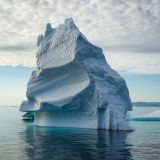James Balog
A Time Capsule From the Anthropocene
Arboretum
For forty years, James Balog has consistently broken new creative and conceptual ground in probing the relationship between humanity and the rest of the natural world. Blending art and science, Balog’s photographs deliver profound insights about the environment today.
Our current epoch of geologic time is known as the “Anthropocene” to reflect the pervasive and enduring traces left on Earth.
James Balog’s work is the most all-encompassing visual exploration of the Anthropocene yet produced. It touches on many interconnected issues: climate change, melting glaciers, rising seas, wildfires, air quality degraded by wildfire smoke, unusually ferocious storms and floods, ocean warming, endangered wildlife, and deforestation.
His imagery is both symbolic and documentary. It is the personal expression of an artist of his time in history, combined with an effort to stimulate positive social behaviour on behalf of humanity and nature.
This motivation is summarised in one of his many writings: “No boundary separates people from nature. In damaging nature we are damaging ourselves. In protecting nature we are protecting ourselves… We the people have an inalienable right not just to life, liberty, and the pursuit of happiness, but to clean air, clean water, and the security of a stable atmosphere.”
Curated by Lois Lammerhuber / Printed by ![]()
Discover here contributions of ETH Zurich to the Sustainable Development Goal (SDG) 13:
Planning for losses from climate change
CLIMADA
Dr. Chahan Kropf, Dr. Lukas Riedel and Emanuel Schmid are leading the development of CLIMADA, a state-of-the-art model designed to estimate the economic impacts of climate change. Two of them, Chahan and Lukas, are physicists by training, and have studied in Switzerland, Germany, and Italy. They share a deep love and respect for the environment that was nurtured since childhood. Their fascination with climate risk emerged during their research, teaching, and public engagement on the topic.
CLIMADA
CLIMADA is an open-source software that uses sophisticated probabilistic modelling to estimate the impact of extreme weather events in a changing climate. It starts off by working out the losses expected given the risk of today, then estimates how much damage can be expected by factoring in socio-economic changesas well as climate change, and finally how much risk can be reduced with various adaptation measures. The team has developed the software so it can be used to estimate the impact of natural disasters such as floods, tropical cyclones, or heatwaves. Their model considers all dimensions of socio-economic impacts– from damage to houses, farmland, power plants and trainlines, to effects on lives, livelihoods, and migration, to the disruption of ecosystems such as forests, coral reefs, and alpine fauna.
The goal of CLIMADA is to provide politicians, humanitarian organisations, businesses and other policy-makers with a solid, science-based tool to guide decisions on adapting to global warming.
How to adapt to the climate crisis
Global warming is the underlying threat already having profound effects on all life on Earth. Even today’s technologically advanced societies depend on a stable climate, are vulnerable to more frequent and intense natural hazards, and have to accept a high level of risk even with the most optimistic climate scenarios. The need to adapt to climate change is no longer negotiable, and this means that any delay in adaptation efforts will increase the cost and suffering to society. But adaptation also has its limits, so it is vital to reduce carbon dioxide emissions drastically.
Looking to the future, the software developers plan to bolster the impact of CLIMADA by increasing its capacity to predict risk from various hazards at the same time. They also plan to develop methodologies that capture the long-term effects of natural hazards on global ecosystemsin a changing climate, including impacts on the provision of services such as clean drinking water or erosion protection. Another ambition is to develop a modelling framework similar to a meteorological forecast to support humanitarian work.
The CLIMADA team wants to share a piece of advice: when planning your future endeavours – buying a house, for example – do not expect the past to be a good guide, but keep in mind potential risks from unprecedented natural hazards such as severe flooding, intense hailstorms, landslides, or droughts.
“Environmental sustainability is only achievable together with a sustainable and fair society. Currently, this seems out of scope.”
Dr. Chahan Kropf, CLIMADA at ETH Zurich
Tracing links from distant glaciers to everyday life
Daniel Farinotti
Professor Daniel Farinotti’s fascination for high alpine and polar regions is fuelled by a love for nature, adventure, and science. After training as an environmental engineer at ETH Zurich, he became immersed in research on glaciers and glaciology during his postgraduate studies.
What does a glacier expert do?
Today, Daniel leads a research group with four main strands of work. Their research on large-scale impacts asks how glaciers grow and shrink, and how these processes affect environmental issues such as water resources, sea level rise, or biodiversity. The second strand is fundamental research in glaciology, which seeks to understand glaciers in the very detail: how they move, how water flows within and beneath them, or how they erode sediments on which they rest. The third strand focuses on monitoring. The group observes and keeps track of how glaciers change, collaborating with partners from the Universities of Zurich and Fribourg to monitor Swiss glaciers. Through the fourth strand, contract research, the group addresses questions posed to them by public and private entities. These questions can relate to anything from the future water availability in a basin used for hydropower, to the hazards emerging from a particular glacier or glacier lake.
Daniel’s ambition is to help solve any glacier-related problem with implications for society – be it for water-supply security, the management of hazards, or long-term changes in important natural systems like watersheds.
Water availability is crucial for any society; so is the need for safety. Both are affected by glaciers. When it comes to sea level rise, the implications are global: more than 200 million people live within 1 metre above sea level. Imagine what challenges society would face if all these people needed to move, and all the infrastructure they used had to be rebuilt. According to the latest projections, 1 metre of sea level rise by the year 2100 cannot be ruled out.
Let’s take care of our planet Earth
Our planet is a complex and interconnected system. We may not be in daily contact with snow, ice, and glaciers, but changes in these elements affect the natural system, and therefore our society worldwide.
Planet Earth is our home, an incredibly beautiful yet unimaginably tiny place in the universe – and we don’t have a second home. Climate change, biodiversity loss, overexploitation of resources and pollution pose unprecedented challenges. Daniel remains hopeful that we, as a society, will eventually find a way to live sustainably, using resources at the rate in which they are naturally replaced – even though today, we are further away from this goal than ever before.
“Each one of us should contribute to preserving our planet. It is too valuable to be given up.”
Prof. Dr. Daniel Farinotti, Head of the Professorship of Glaciology, at the Laboratory of Hydraulics, Hydrology and Glaciology (VAW) at ETH Zurich
The financial barriers to climate action
Bjarne Steffen
Before joining ETH Zurich as Professor of Climate Finance and Policy, Professor Bjarne Steffen worked as an economist in management consulting and at the World Economic Forum, focusing on energy and clean transport infrastructure.
Climate finance and policy
Working in the industry, Bjarne gained deep insights into how energy utilities transition (or not) to low-carbon technologies like renewables, and how new ‘green’ energy companies struggle to get into the market. The mitigation of climate change requires massive investments in new technologies, and favourable conditions for such investments to pay off. But as things stand, such investments are far from where they would need to be, with large gaps especially in developing countries that urgently need to invest for both mitigation and adaptation.
Moving towards net zero
Working with his climate finance and policy research group, Bjarne now studies how public policy affects the transition to new and clean technologies for climate change mitigation. That may involve moving from fossil fuels to renewables, for example, or from internal combustion engines to electric cars, or building negative emission technologies. The researchers focus on the role of the finance sector in making the transition happen – such as decisions made by banks or pension funds, or the impact of different financial policies.
Bjarne and his team ask a number of questions in the course of this work. How do technologies differ in the types of finance they require? How do financial institutions decide between technologies? How do public policies affect the availability and cost of capital for new technologies? Based on insights into these questions, they advise policymakers on how to mobilise finance for climate action.
“We have the technologies, now we need the policies to mobilise finance at scale”
To meet the climate goals of the Paris Agreement, and to make progress on the SDGs, investments in clean energy technologies need to increase rapidly and massively. Bjarne’s research shows that in Europe, this translates to an immediate 40% rise in investments. In the Global South, the investment gap is even larger. His analysis reveals that the energy transition is hindered often not by technological challenges, but by a lack of institutional structures – public policies in particular – that can mobilise and channel investments into sectors with a huge potential to power transformations to sustainability.
“Thanks to the phenomenal progress with solar photovoltaics and batteries, we have the technologies at hand to provide access to clean energy to hundreds of millions within the next decade. The challenge is to mobilise finance at scale. Effective public policies are key to that end.”
Prof. Dr. Bjarne Steffen, Assistant Professor of Climate Finance and Policy at ETH Zurich
open your eyes festival buerau
Botenaustrasse 42
9443 Widnau
Switzerland
Phone: +41 44 218 11 03





